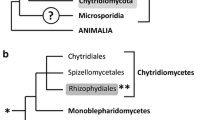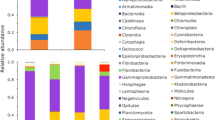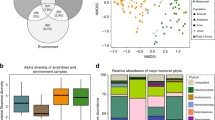Abstract
Chytridiomycosis is an amphibian skin disease that threatens amphibian biodiversity worldwide. The fungal agent of chytridiomycosis is Batrachochytrium dendrobatidis. There is considerable variation in disease outcomes such that some individuals and populations co-exist with the fungus and others quickly succumb to disease. Amphibians in populations that co-exist with the B. dendrobatidis have sublethal infections on their skins. Symbiotic skin bacteria have been shown in experiments and surveys to play a role in protecting amphibians from chytridiomycosis. Little is known about the mechanisms that antifungal skin bacteria use to ameliorate the effects of B. dendrobatidis. In this study, we identified that B. dendrobatidis isolate JEL 310 zoospores display chemotaxis, in the presence of two bacterially-produced metabolites (2,4-diacetylphloroglucinol and indole-3-carboxaldehyde). In the presence of either metabolite, B. dendrobatidis zoospores move more frequently away from the metabolite. Using parameters estimated from this study, a simple stochastic model of a random walk on a lattice was evaluated. The model shows that these individual behaviors over short time-scales directly lead to population behaviors over long time–scales, such that most zoospores will escape, or not infect a tryptone substrate containing the bacterially-produced metabolite, whereas many zoospores will infect the tryptone substrate containing no metabolite. These results suggest that amphibians that have skin bacteria produce antifungal metabolites that might be able to keep B. dendrobatidis infections below the lethal threshold and thus are able to co-exist with the fungus.





Similar content being viewed by others
References
Becker MH, Brucker RM, Schwantes CR, Harris RN, Minbiole KPC (2009) The bacterially produced metabolite violacein is associated with survival of amphibians infected with lethal fungus. Applied and Environmental Microbiology 75(21):6635-6638.
Berger L, Hyatt AD, Speare R, Longcore JE (2005) Life cycle stages of the amphibian chytrid Batrachochytrium dendrobatidis. Diseases of Aquatic Organisms 68(1):51-63.
Blaustein AR, Romansic JM, Scheessele EA, Han BA, Pessier AP, Longcore JE (2005) Interspecific variation in susceptibility of frog tadpoles to the pathogenic fungus Batrachochytrium dendrobatidis. Conservation Biology 19:1460-1468.
Bosch J, Martinez-Solano I, Garcia-Paris M (2001) Evidence of a chytrid fungus infection involved in the decline of the common midwife toad (Alyetes obstericans) in protected areas of central Spain. Biological Conservation 97(3):331-337.
Briggs CJ, Knapp RA, Vredenburg VT (2010) Enzootic and epizootic dynamics of the chyrid fungal pathogen of amphibians. Proceedings of the National Academy of Sciences (USA) 107:9695-9700.
Brucker RM, Baylor CM, Walters RL, Lauer A, Harris RN, Minbiole KPC (2008a) The identification of 2,4-diacetylphloroglucinol as an antifungal metabolite produced by cutaneous bacteria of the salamander Pethodon cinereus. Journal of Chemical Ecology 34:39-43.
Brucker RM, Harris RN, Schwantes CR, Gallaher TN, Flaherty DC, Lam BA, Minbiole KPC (2008b) Amphibian chemical defense: antifungal metabolites of the microsymbiont Janthinobacterium lividum on the salamander Plethodon cinereus. Journal of Chemical Ecology 34(11):1422-1429.
Carey C, Alexander MA (2003) Climate change and amphibian declines: is there a link? Diversity and Distributions 9(2):111-121.
Carey C, Bruzgul JE, Livo LJ, Walling ML, Kuehl KA, Dixon BF, Pessier AP, Alford RA, Rogers KB (2006) Experimental exposures of Boreal toads (Bufo boreas) to a pathogenic chytrid fungus (Batrachochytrium dendrobatidis). EcoHealth 3:5-21.
Davidson EW, Parris M, Collins JP, Longcore JE, Pessier AP, Brunner J (2003) Pathogenicity and transmission of chytridiomycosis in tiger salamanders (Ambylostoma tigrinum). Copeia 3:601-607.
Feller, W (1968) An Introduction to Probability Theory and Its Applications. Volume 1, New York: John Wiley and Sons.
Hanselmann R, Rodriquez A, Lampo M, Fajardo-Ramos L, Aguirre AA, Kilpatrick AM, Rodriquez JP, Daszak P (2004) Presence of an emerging pathogen of amphibians in introduced bullfrogs Rana catesbeiana in Venezuela. Biological Conservation 120(1):115-119.
Harris RN, James TY, Lauer A, Simon MA, Patel M (2006) The amphibian pathogen Batrachochytrium dendrobatidis is inhibited by the cutaneous bacteria of amphibian species. EcoHealth 3:53-56.
Harris RN, Brucker RM, Walke JB, Becker MH, Schwantes CR, Flaherty DC, Lam BA, Woodhams DC, Briggs CJ, Vredenburg VT, Minbiole KPC (2009a) Skin microbes on frogs prevent morbidity and mortality caused by a lethal skin fungus. ISME Journal 3(7):818-824.
Harris RN, Lauer A, Simon MA, Banning JL, Alford RA (2009b) Addition of antifungal skin bacteria to salamanders ameliorates the effects of chytridiomycosis. Diseases of Aquatic Organisms 83(1):11-16.
James TY, Litvintseva AP, Vilgalys R, Morgan JAT, Taylor JW, Fisher MC, Berger L, Weldon C, Du Preez L, Longcore JE (2009) Rapid global expansion of the fungal chytridiomycosis into declining and healthy amphibian populations. PLOS Pathogens 5(5). Art. no. e1000458.
Lam BA, Walke JB, Vredenburg VT, Harris RN (2010) Proportion of individuals with anti-Batrachochytrium dendrobatidis skin bacteria is associated with population persistence in the frog Rana muscosa. Biological Conservation 143(2):529-531.
Lauer A, Simon MA, Banning JL, Andre E, Duncan K, Harris RN (2007) Common cutaneous bacteria from eastern red-backed salamander can inhibit pathogenic fungi. Copeia (3):630-640.
Lauer A, Simon MA, Banning JL, Lam BA, Harris RN (2008) Diversity of cutaneous bacteria with antifungal activity isolated from female four-toed salamanders. ISME Journal 2:145-157.
Longcore JE, Pessier AP, Nichols DK (1999) Batrachochytrium dendrobatidis gen. et sp. Nov., a chytrid pathogenic to amphibians. Mycologia 91:219-227.
Moss AS, Reddy NS, Dortaj IM, San Francisco MJ (2008) Chemotaxis of the amphibian pathogen Batrachochytrium dendrobatidis and its response to a variety of attractants. Mycologia 100(1):1-5.
Morehouse EA, James TY, Ganley ARD, Vilgalys R, Berger L, Murphy PJ, Longcore JE (2003) Multilocus sequence typing suggests the chytrid pathogen of amphibians is a recently emerged clone. Molecular Ecology 12(2):395-403.
Pessier AP, Nichols DK, Longcore JE, Fuller MS (1999) Cutaneous chytridiomycosis in poison dart frogs (Dendrobates spp.) and white’s tree frogs (Litoria caerulea). Journal of Veterinary Diagnostic Investigation 11:194-199.
Poitrowski JS, Annis SL, Longcore JE (2004) Physiology of Batrachochytrium dendrobatidis, a chytrid pathogen of amphibians. Mycologia 96(1):9-15.
Rachowicz LJ, Vredenburg VT (2004) Transmission of Batrachochytrium dendrobatidis within and between amphibian life stages. Diseases of Aquatic Organisms 61(12):75-83.
Rachowicz LJ, Knapp RA, Morgan JAT, Stice MJ, Vredenburg VT, Parker JM, Briggs CJ (2006) Emerging infectious disease as a proximate cause of amphibian mass mortality. Ecology 87(7):1671-1683.
Retallick RWR, McCallum H, Speare R (2004) Endemic infection of the amphibian chytrid fungus in a frog community post-decline. PLOS 2(11).
Skerratt LF, Berger L, Speare R, Cashins S, McDonald KR, Phillott AD, Hines HB, Kenyon N (2007) Spread of chytridiomycosis has caused rapid global decline and extinction of frogs. EcoHealth 4(2):125-134.
Taylor HM, Karlin S (1984) An Introduction to Stochastic Modeling Orlando, FL: Academic Press.
Voyles J, Berger L, Young S, Speare R, Webb R, Warner J, Rudd D, Skerratt LF (2007) Electrolyte depletion and osmotic imbalance in amphibians with chytridiomycosis. Diseases of Aquatic Organisms 77(2):105-112.
Voyles J, Young S, Berger L, Campbell C, Voyles WF, Dinudom A, Cook D, Webb R, Alford RA, Skerratt LF, Speare R (2009) Pathogenesis of chytridiomycosis, a cause of catastrophic amphibian declines. Science 326:582-585.
Vredenburg VT, Knapp RA, Tunstall TS, Briggs CJ (2010) Dynamics of an emerging disease drive large-scale amphibian population extinctions. Proceedings of the National Academy (USA) 107 (21):9689-9694.
Weller DM, Landa BB, Mavrodi OV, Schroeder KL, Fuente DL, Bankhead SB, Molar RA, Bonsall RF, Mavrodi DV, Thomashow LS (2007) Role of 2,4-diacetylphloroglucinol-producing fluorescent Pseudomonas spp. in the defense of plant roots. Plant Biology 9:4-20.
Woodhams DC, Ardipradja K, Alford RA, Marantelli G, Reinert LK, Rollins-Smith LA (2007a) Resistance to chytridiomycosis varies among amphibian species and is correlated with skin peptide defenses. Animal Conservation 10(4):409-417.
Woodhams DC, Vredenburg VT, Stice MJ, Simon MA, Billheimer D, Shakhtour B, Shyr Y, Briggs CJ, Rollins-Smith LA, Harris RN (2007b) Symbiotic bacteria contributed to innate immune defenses of the threatened mountain yellow-legged frog, Rana muscosa. Biological Conservation 138:390-398.
Wyngaard GA, Chinnappa CC (1982) General biology and cytology of cylopoids. In Harrison, F. W., and Cowden, R. R. (eds), Developmental Biology of Freshwater Invertebrates. Alan R. Liss, New York, pp. 485–533.
Acknowledgments
We would like to thank Dr. Joyce Longcore for supplying our Bd isolate and Dr. Alex Bannigan for her expertise in microscopy. The research was supported by NSF grant 0640373.
Author information
Authors and Affiliations
Corresponding author
Rights and permissions
About this article
Cite this article
Lam, B.A., Walton, D.B. & Harris, R.N. Motile Zoospores of Batrachochytrium dendrobatidis Move Away from Antifungal Metabolites Produced by Amphibian Skin Bacteria. EcoHealth 8, 36–45 (2011). https://doi.org/10.1007/s10393-011-0689-7
Received:
Revised:
Accepted:
Published:
Issue Date:
DOI: https://doi.org/10.1007/s10393-011-0689-7




